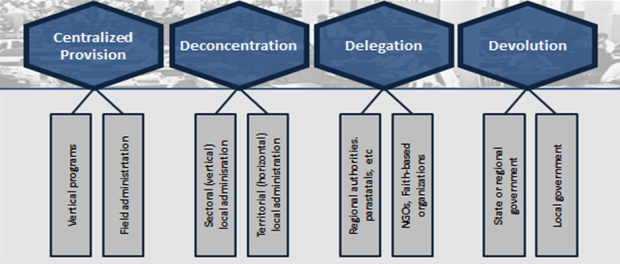The local public sector can be defined as the part of the public sector that interacts with citizens, civil society and the private sector in a localized manner. As such, it is where residents and businesses receive services from the public sector and where citizens regularly interact with public servants and government officials.
The most common way for the public sector to interact with people at the local level is through elected local governments. When local government officials are responsive to the needs of their constituents, devolution can increase the responsiveness, effectiveness and accountability of the public sector.
In addition to providing services through local governments, there are several other ways in which the public sector interacts with people and provides—or supports— public service delivery at the local level. These non-devolved approaches to decentralization and localization are part and parcel of the local public sector.
For instance, in many countries, local administrative units or local departments of central line ministries provide public services in a ‘deconcentrated’ manner. In addition, central authorities often provide grants or subsidies to para-statal organizations, semi-autonomous corporations, non-governmental organizations (NGOs) or faith-based organizations (FBOs) in order to deliver certain public services on behalf of the central government in a delegated manner. Likewise, central government line ministries sometimes provide direct support to local public services. For instance, centralized or direct support for localized services takes place when central line ministries supply schoolbooks or medicines that are used in local schools and clinics, or when a central agency funds directly funds the construction of classrooms or other local infrastructure.
Depending on how broadly or how narrowly one wants to define the concept, each of these different modalities may be included in the methodology used to define and measure the local public sector.
Most countries do not rely exclusively on one approach or the other. Instead, many countries rely on a collaborative multi-level governance system where local public services are provided through a combination of different mechanisms at the same time. The Local Public Sector Alliance seeks to identify under which conditions each of these institutional mechanisms is an appropriate and efficient way to deliver public services, in order to unlock the potential of the local public sector.

